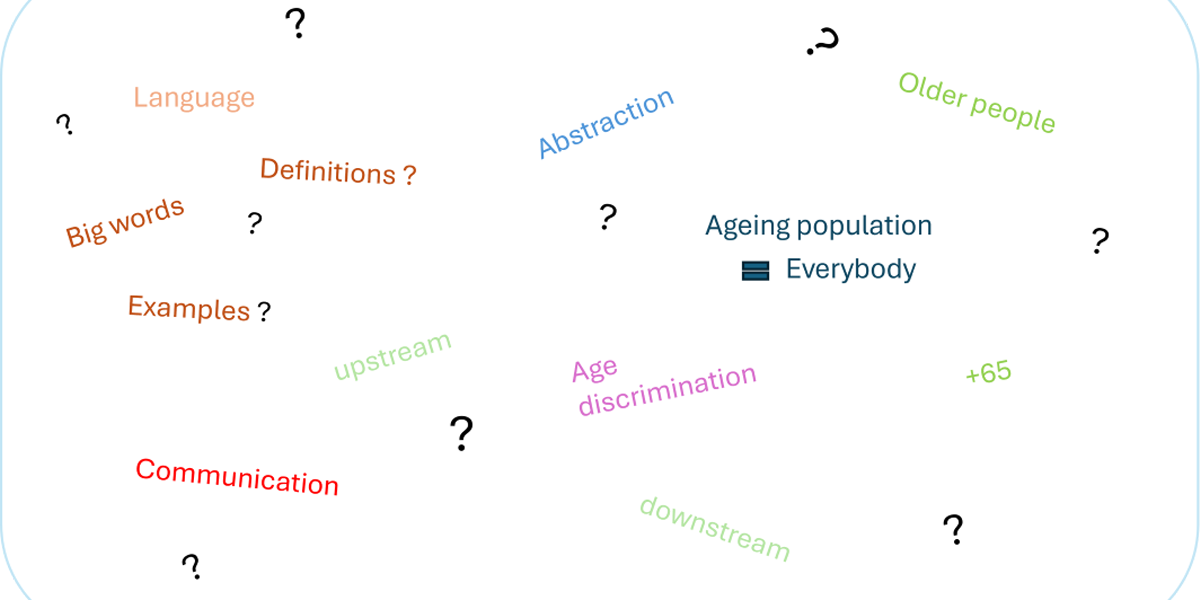This blog post reports on work-in-progress within the DfG course! The post is written by the workstream on ‘Ageing Population‘ dealing with the Ministry of Finance’s brief on ‘Open Government’. The group includes Sushmita Charlu from the Creative Sustainability Program (Aalto) and Thalia Zelißen from the Environmental Engineering Program (TU Munich).
Written by: Thalia Zelißen
One of the two 2025 project briefs of the master’s course “Design for government” is called “Open Governance – unlocking the possibilities to innovate the current Open Governance Action Plan by re-imagining the involvement and role of the elderly population in Finnish governance “. Getting started, the first stage of the course was about setting up the context, which means gaining a holistic understanding of open governance in regard to Finland´s ageing population. Our supergroup was divided into different workstreams to cover the big picture while sharing the work. To explain, a supergroup means everybody dealing with the open governance project brief. Within this supergroup, four workstreams were formed. My partner Sushmita Charlu and I focused on “Ageing population and public services”, while others covered the open governance approach on different levels (international, national, and municipal); a third group researched elderly participation initiatives, and the fourth workstream dealt with the Action plan and elderly inclusion.
The cover photo shows how my brain often felt like during the first stage of the Design for Government project. Overloaded, but in a positive way. The first three weeks were all about new and big words popping up, deep systematic and ethical reflections, and confusion about politicians’ language. All this combined led to a lot of question marks in my head. In parallel to that overwhelmed feeling, a feeling of excitement grew. Excitement to identify entry points to change things and excitement to learn to address visions properly to really conceptualise inspirational proposals for policy-makers.
Understanding the phenomenon of ageing population
When we were introduced to our workstream “ageing population and public services,” we were asked to “understand the phenomenon of the ageing population” (Nuria Solsona, 2nd lecture session). That was immediately a heavy challenge to abstract myself from my very downstream perspective, meaning an implementation-focused and hands-on perspective. I had to free myself from my very practical ideas like wanting to understand how older people feel in society and how they use public services right now. The new perspective to take was a more holistic one, trying to understand the broader, holistic picture through questions like:
– How is the increasing share of older people in our society perceived?
– And what are the drivers for this perception?
This broader and more abstract perspective is also called the “upstream” perspective. It is the one policy-makers usually take.
While starting our research from this perspective during the first 2 weeks, we identified primary aspects of how the increased share of older people in our society is perceived. We identified a foremost negative tone when people talk about elderly people, creating a picture of them being rather takers than givers or even being a burden for society. Age discrimination (also called ageism) is one underlying aspect driving this perception (Weir, 2023). Furthermore, age-based difficulties in handling digital tools that provide information or political participation possibilities drive exclusion even more. Social exclusion from society is likely to foster rapid physical and cognitive decline (Saha et al., 2023).

Figure 1: Illustration – overall perception of elderly people (ChatGPT, 2025)
Still, we recognized an overall willingness of older people to participate in politics, especially in co-designing services that become more important with age; for example, the health system (THL, 2023). Because of the lack of proper entry points to participation for elderly people, their most used political participation method is still voting (Huttunen & Christensen, 2024).
The overall increase in the older population contrasts with the decreasing number of young people (see ). This puts high pressure on the current pension and caretaking system, which continuously develops towards more family caretaking. Companies cutting costs is one driver for this increase in family caretaking (Sjögren, 2025). Seeing that, combined with the fact that elderly people are numerously represented in votes and thus probably highly represented in the course of the government, gives us the oppressing feeling that the different generations could drift apart from each other. We see the risk that a feeling of being overloaded and not seen could occur on the side of the younger generations and only be a burden for society or put at the side like an object on the side of the older generation. It will be exciting to think about how to foster intergenerational understanding and if and what system changes could help to address these challenges and get more benefits from the older generations.
Understanding the policy-makers’ thinking and language
Besides getting the abstract perspective on our topic, a key learning right at the beginning of the course was the importance of understanding the thinking and language of your partners, in this case politicians and civil servants. When you have a look for instance at politicians discussing either with other politicians and experts or talking to the public, you will quickly recognize that you might not understand all the words they use. Maybe you literally do, but you might not get their meaning or miss examples of what they actually think of. For me, recognizing that highlighted the great need to understand their thinking and language so that our future improvement proposals will not be discarded. Because they will be useless when we do not consider our partners´thinking and language in our proposals (Design Indaba, 2020).
Besides aiming to become comfortable with upstream thinking and language use there are other things I learned in the first stage of this course about a proper way of communication in the upstream environment. Firstly, one should show an understanding of the complexity of systems and secondly, recognize that change cannot be radical because the whole system needs to be running in parallel to change. Being supervised by three experienced teachers in this field and having the possibility to experience communication with politicians and civil servants on our own in the following weeks will be a great basis to enhance knowledge in this field!
I am really looking forward to diving deeper into more research, reflecting on the upcoming roundtable discussion, and everything else to come! The following blogs will give more insights into our findings from research, and the next course sessions which will be about system analysis, human-centered research, and finally, the finalization of our proposals to improve the open governance approach regarding the elderly population.
References:
ChatGPT. (2025). [Illustration – overall perception of elderly people]. OpenAI.
Design Indaba. (2020, February 4). Roger Martin on leveraging design in business [Video]. YouTube.
Huttunen, J., & Christensen, H. S. (2024). Act your age! Generational differences in political participation in Finland 2007–2019. In Political behaviour in contemporary Finland.
Saha, P., Salmela, J., Lallukka, T., & Aho, A. L. (2023). Functioning changes in varying ways after retirement: A scoping review. Inquiry: The Journal of Health Care Organization, Provision, and Financing, 60. https://doi.org/10.1177/00469580221142477
Sjögren, H. (2025, March 4). Intro Talks, Ageing panel [Lecture session].
THL (Finnish Institute for Health and Welfare). (2023). Statistical report 45/2023. The adult population’s well-being and health – Healthy Finland survey 2022. https://www.julkari.fi/handle/10024/147165
Weir, K. (2023, August 28). Ageism is one of the last socially acceptable prejudices. Psychologists are working to change that. APA Monitor on Psychology. https://www.apa.org/monitor/2023/09/news-ageism
The DfG course runs for 14 weeks each spring – the 2025 course has now started and runs from 24th Feb to 27th May. It’s an advanced studio course in which students work in multidisciplinary teams to address project briefs commissioned by governmental ministries in Finland. The course proceeds through the spring as a series of teaching modules in which various research and design methods are applied to address the project briefs. Blog posts are written by student groups, in which they share news, experiences and insights from within the course activities and their project development. More information here about the DfG 2025 project briefs. Hold the date for the public finale on Tuesday 27th May!

